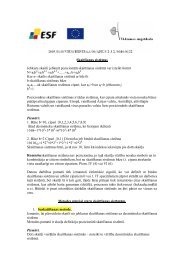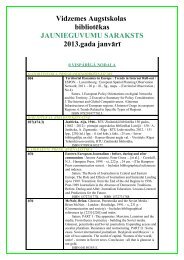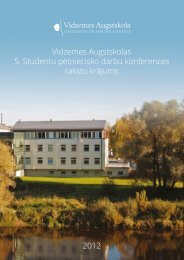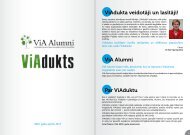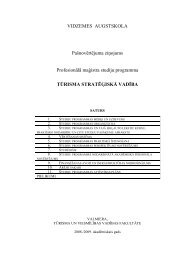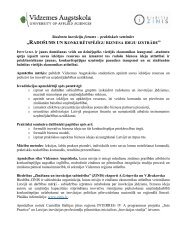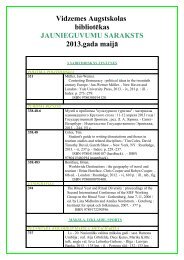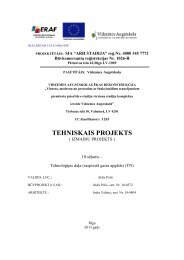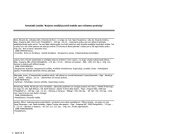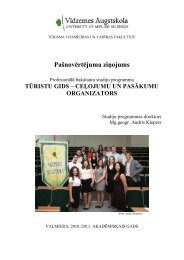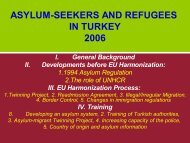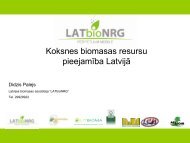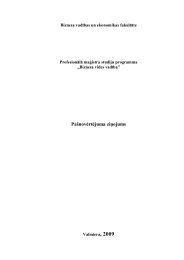Proceedings
Proceedings
Proceedings
Create successful ePaper yourself
Turn your PDF publications into a flip-book with our unique Google optimized e-Paper software.
Sustainable Planning Instruments and Biodiversity Conservation<br />
Parks of the World. 2008c. Park Classification System. http://<br />
parksoftheworld.org/classification.html.<br />
Parks and Gardens, UK. http://www.parksandgardens.ac.uk/.<br />
Payne, R. and Graham, R. 1993. Visitor Planning and Management<br />
in Parks and Protected Areas. Parks & Protected<br />
Areas in Canada: Planning and Management (eds.<br />
Dearden, P. and Rollins, R.). Oxford University Press,<br />
pp. 185–210.<br />
Pennsylvania Department of Conservation and Natural<br />
Resources. http://www.dcnr.state.pa.us/brc/heritagepark.<br />
Saaty, T. L. 1997. That Is Not the Analytic Hierarchy Process:<br />
What the AHP Is and What It Is Not. Journal of Multi-<br />
Criteria Decision Analysis 6(6), 324–335.<br />
Saaty, T. L., Roger, P. C. and Pell, R. 1980. Portfolio Selection<br />
through Hierarchies. Journal of Portfolio Management<br />
6(3), 16–21.<br />
Saaty, T. L. 1990. How to Make a Decision: The Analytic<br />
Hierarchy Process. European Journal of Operational<br />
Research 48, 9–26.<br />
Shelby, Bo, Heberlein, Thomas A. 1984. A Conceptual<br />
Framework for Carrying Capacity Determination. Leisure<br />
Sciences 6, 433–452.<br />
Swiss National Park. http://www.myswitzerland.com/en.cfm/<br />
about_switzerland/offer.cfm?category=About_TopAttract<br />
ions&subcat=Nature&id=8662.<br />
Wagar, J. A. 1974. Recreational Carrying Capacity Reconsidered.<br />
Journal of Forestry 72 (5), 274–8.<br />
Wagar, J. A. 1964. The Carrying Capacity of Wild Land for<br />
Recreation. Forest Science Monograph 7. Society of<br />
American Foresters. http://www.archive.org/write-review.<br />
php?identifier=forestryresearch019721mbp.<br />
Wasil, E. and Golden, B. 2003. Celebrating 25 years of AHPbased<br />
decision making. Computers and Operations<br />
Research 30, 1419–20.<br />
World Conservation Monitoring Centre (WCMC). 2004.<br />
http:// www.unep-wcmc.org/ – 42k.<br />
World Tourism Organization (WTO). 1981. Saturation of<br />
Tourist Destinations: Report of the Secretary General.<br />
Madrid.<br />
Consumptive Tourism and Conservation of Natural Resources<br />
YUKICHIKA KAWATA 1<br />
Abstract<br />
There are two types of natural resource use: consumptive and non-consumptive. The former is a traditional style<br />
of usage exemplified by hunting, processing, and the physical consumption of natural resources, whereas the latter<br />
is a relatively recent style of usage exemplified by ecotourism and/or green tourism. A shift from consumptive to<br />
non-consumptive use may result in the decrease of natural resources, which may lead to some problematic issues.<br />
For example, game animals have traditionally been utilized physically; this reduces their population size and<br />
contributes to the alleviation of agricultural/forestry damages. However, as the non-consumptive use becomes more<br />
prevalent, people tend to be more inclined toward the protection of natural resources; this results in an increase in<br />
the game population, which causes further damage to agriculture and forests, as well as vegetation. Therefore, for the<br />
conservation of the local landscape as a whole, consumptive use should be maintained. In order to examine this topic,<br />
first, we address the problem in greater detail; second, we search for a solution and propose consumptive tourism; and<br />
finally, we discuss the remaining issues of our research.<br />
1 Introduction<br />
The human being has various kinds of routine relationships<br />
with the natural environment, which take tangible<br />
and intangible forms and, as a result, we have received<br />
tremendous spiritual and physical influences from the<br />
natural environment. The relationship between the human<br />
being and the natural environment is not stationary. Most<br />
of the natural environment changes because of succession<br />
and disturbance while human society changes because<br />
of economic development, technology advancement and<br />
cultural transformation. As a result, the relationships<br />
between the natural environment and human society<br />
change continuously. Nevertheless, if the natural<br />
environment and human society successfully coexists,<br />
it may happen because the speed of mutual intervention<br />
and/or the speed of transition are appropriate to each<br />
other.<br />
The natural environment can be classified into the<br />
wilderness areas and secondary nature. A wilderness<br />
area is the state when succession has finished, and it is in<br />
a stable condition. On the other hand, secondary nature<br />
is formed by human influences to varying degrees. In<br />
other words, secondary nature belongs to the so-called<br />
cultural landscapes. It is not easy to define cultural<br />
landscape, but in the broad sense, it is seen as natural<br />
environment which has been affected by human beings<br />
in the full sense. The situation is quite different in the<br />
case of human society. When technology advancement<br />
is slow, or similar politics and culture sustain for long<br />
periods, human society is relatively stable throughout<br />
the time. However, as economy develops, it seems that<br />
the speed of social change tends to accelerate.<br />
When the percentage of the wilderness area in the<br />
whole natural environment is high and the speed of<br />
change in human society is slow, the relationship between<br />
the natural environment and human society changes<br />
slowly. The speed of change of both natural environment<br />
and human society is so slow that both can cope with<br />
the change of the other. However, when the percentage<br />
of secondary nature in the whole natural environment<br />
is high and the speed of change in human society is<br />
high, there is a higher possibility that the relationships<br />
between the natural environment and human society<br />
change drastically in the short term. In this case, nature<br />
cannot keep up with the change of human society, and in<br />
some cases nature is forced to undergo irreversible and<br />
rapid change.<br />
To use some examples – large-scale development of<br />
rainforests, extermination of wild game animals, introduction<br />
of alien invasive species and huge development<br />
of rivers and lakes such as the Aral Sea. All of these<br />
are drastic changes in the natural environment which are<br />
attributed to the excessive use of the natural environment<br />
or its components by human beings. We can show<br />
1<br />
Division of Food Hygiene, Department of Animal and Food Hygiene, Obihiro University of Agriculture and Veterinary<br />
Medicine, Inada-cho, Obihiro, Hokkaido 080-8555, Japan, e-mail: ykawata@obihiro.ac.jp.<br />
34<br />
35



